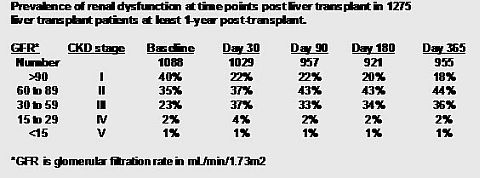Change in Glomerular Filtration Rate (GFR) in the First Year Post Liver Transplant
Transplant Division, Dept of Surgery, Indiana University, School of Medicine, Indianapolis, IN
Meeting: 2013 American Transplant Congress
Abstract number: D1683
Baseline renal function is an important factor in post liver transplant (LT) outcome. This study examines the change in glomerular filtration rate (GFR) in the first year post LT, and clinical outcomes for patients with varying degrees of renal dysfunction. The records of 1275 consecutive deceased donor, liver and liver/kidney transplants were reviewed, with the liver/kidney data analyzed separately. Among liver only patients, 25% had GFR<60mL/min at LT, and this increased to 39% at 1-year. There were 42% of patients with normal renal function (GFR > 90mL/min) at baseline and this decreased to 18% at 1-year. Only patient subgroups with MELD > 25 experienced any 1-year improvement in GFR, which was minimal, while all lower MELD groups experienced a significant decline in GFR. Cox survival curves demonstrate a worsening survival corresponding to worse pre-LT renal function. At 1-year post-transplant, there were 42% of recipients that had an absolute GFR decrease >20mL/min, and 39% that decreased >25% from their transplant baseline. Only 22% had an improvement in GFR >5mL/min. In conclusion, 64% of liver transplant recipients overall experience a decrease in GFR 1-year post-transplant. Recipients with severe kidney disease at transplant are the group most likely to experience improvement in GFR post transplant. But, at 1-year, as a group, they remain at GFR <50mL/min (stage III chronic kidney disease). These results suggest that severe renal dysfunction may be marginally reversible post liver transplant, but only 22% of recipients in this study experienced post-LT improvement in renal function.

To cite this abstract in AMA style:
Bush W, Mangus R, Lutz A, Fridell J, Vianna R, Kubal C, Tector A. Change in Glomerular Filtration Rate (GFR) in the First Year Post Liver Transplant [abstract]. Am J Transplant. 2013; 13 (suppl 5). https://atcmeetingabstracts.com/abstract/change-in-glomerular-filtration-rate-gfr-in-the-first-year-post-liver-transplant/. Accessed December 26, 2025.« Back to 2013 American Transplant Congress
